This was the second part of our ‘back to back’ cruising from Sydney in Diamond Princess.
We spent a day in Yokohama before sailing to cruise the Japanese coast and a single foreign port in South Korea, Busan, which is across from Japan via the southern part of the Sea of Japan. We would stay there for a day, before sailing back to the western coast of Japan, and then to return to Yokohama where we would leave the ship and fly home.
 Entering Busan port. Busan used to be called Pusan, but was renamed in 2000. We sailed passed miles of container storage areas, cranes and wharfs, confirming that Busan is Korea’s busiest port, and the ninth busiest in the world. We then sailed under the Gwangandaegyo or Diamond Bridge, before going alongside.
Entering Busan port. Busan used to be called Pusan, but was renamed in 2000. We sailed passed miles of container storage areas, cranes and wharfs, confirming that Busan is Korea’s busiest port, and the ninth busiest in the world. We then sailed under the Gwangandaegyo or Diamond Bridge, before going alongside.
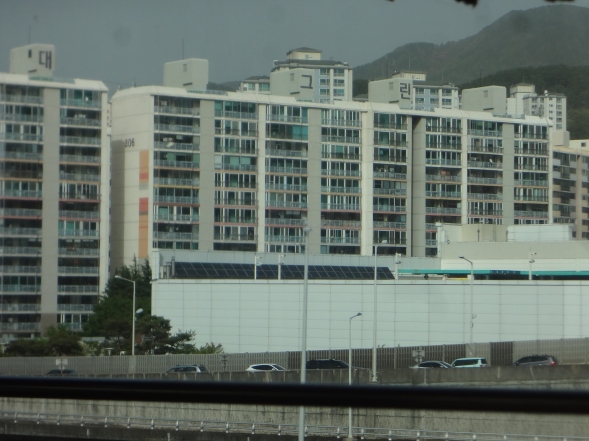 Maureen and I had booked the 100 steps climb to a temple – not being a keen viewers of temples the tour included a visit to a famous fish market, which for us was the main reason for taking the tour.
Maureen and I had booked the 100 steps climb to a temple – not being a keen viewers of temples the tour included a visit to a famous fish market, which for us was the main reason for taking the tour.
The one thing that has stuck in my mind of our visit to Busan was the very large number of apartments – block after block, it reminded me of a Lego city that my grandchildren build. I suppose with a population of about 3.6 million and the usable land being hemmed in by two rivers and a range of mountains the only place left was to build upwards.
 All the city photographs were taken from our coach, some might appear slightly blurred.
All the city photographs were taken from our coach, some might appear slightly blurred.

 Note that this is block number 108 so they have 107 others just like it, but how many more are in this area?
Note that this is block number 108 so they have 107 others just like it, but how many more are in this area?
 As we crossed the Diamond Bridge the shoreline had larger and more expensive looking apartments. A nice coincidence that the Diamond Princess sailed under the Diamond Bridge.
As we crossed the Diamond Bridge the shoreline had larger and more expensive looking apartments. A nice coincidence that the Diamond Princess sailed under the Diamond Bridge.
 After over an hours dive we left the bus and started the climb, not the hundred steps, just a inclining path, which got steeper. The above is a picture of Monuments to family members of the past.
After over an hours dive we left the bus and started the climb, not the hundred steps, just a inclining path, which got steeper. The above is a picture of Monuments to family members of the past.

The start of the Beomeosa Temple, which is 1300 years old.
The lanterns are lit at night and I should imagine would add to the overall ambiance of the climb.
As you see we are now at the beginning of the temple area – still haven’t reached the hundred steps.
The Gate of the Four Heavenly Kings is guarded by theses statues – they guard the entrance to heaven. They look like the do, because they wish to subdue any unruly spirits to their will.
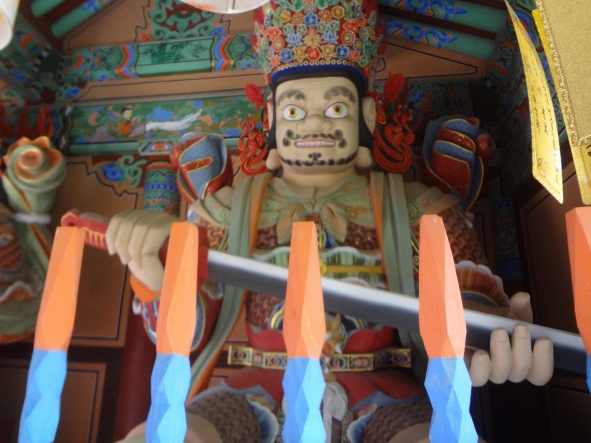



 The final few steps of the one hundred to the top.
The final few steps of the one hundred to the top.
 Inside the temple grounds.
Inside the temple grounds.
 It was a lot easier going down, but one had to be careful as the height of the steps varied, and in places there weren’t any side rails to hold. A sign of age when you look for rails at the side. . .
It was a lot easier going down, but one had to be careful as the height of the steps varied, and in places there weren’t any side rails to hold. A sign of age when you look for rails at the side. . .
 At least going down, once one had passed from the hundred step area, the sound of the small river was pleasant.
At least going down, once one had passed from the hundred step area, the sound of the small river was pleasant.
 Once we were all down, it was back on the bus for the trip to the fish market, just under an hours dive – the traffic was a little lighter.
Once we were all down, it was back on the bus for the trip to the fish market, just under an hours dive – the traffic was a little lighter.
 Not sure if they were a type of octopus or ????
Not sure if they were a type of octopus or ????
 Various crustaceans, which I don’t like.
Various crustaceans, which I don’t like.
 All In know is that the pale worm things were not sausages.
All In know is that the pale worm things were not sausages.
Overall I was disappointed in the fish market – not a bit like I imagined.
 It was not at all like other fish markets that we’ve seen – plastic containers holding packed fish, (still alive) and filled with continuous running water from hoses. Nothing on display, I suppose it is all about what one is used to seeing.
It was not at all like other fish markets that we’ve seen – plastic containers holding packed fish, (still alive) and filled with continuous running water from hoses. Nothing on display, I suppose it is all about what one is used to seeing.

If you can’t afford a place within the market, use the pavement outside.
From the fish market we moved across a main road to the market. Very few items for sale that were not food. The market entrance is under the pink hoops.


 We were only allowed a very short time in both the fish market and this market because we were running late due to traffic jams.
We were only allowed a very short time in both the fish market and this market because we were running late due to traffic jams.
 Strawberries on a stick – you bought the whole stick, which was dripping in some kind of syrup. I wasn’t sure what they were until I got a very close look.
Strawberries on a stick – you bought the whole stick, which was dripping in some kind of syrup. I wasn’t sure what they were until I got a very close look.
The road we crossed to get to this market looked interesting with int’l shops and local shops all mixed, but we didn’t have the time to explore.

It was getting dark so it was back to the ship, which wasn’t all that far from the two markets, and shortly after we sailed for Japan.
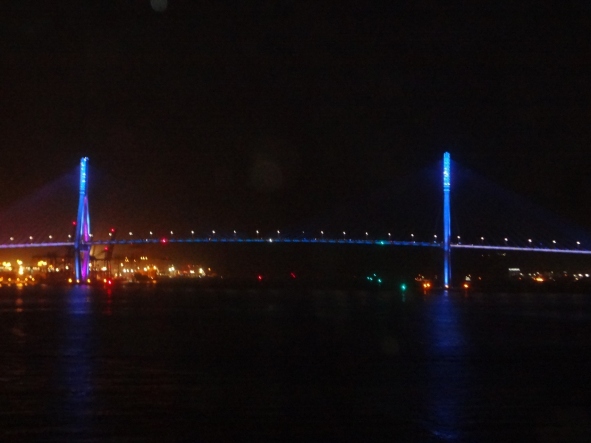
Gwangandaegyo or Diamond Bridge -the same bridge as in the first picture.




 As we walked through the gate on either side hung giant ‘slippers’ made of rice straw. The first pair were produced in 1941 as a thank you gift. There is a long tradition of offering sandals as a thank you gift to temples. The original pair were destroyed during the bombing in WW2.
As we walked through the gate on either side hung giant ‘slippers’ made of rice straw. The first pair were produced in 1941 as a thank you gift. There is a long tradition of offering sandals as a thank you gift to temples. The original pair were destroyed during the bombing in WW2.


 Shinto temple
Shinto temple

 As we prepared to sail the band played on, and the crowds gathered.
As we prepared to sail the band played on, and the crowds gathered. As we pulled away from the wharf everyone ashore started to wave yellow pieces of cloth.
As we pulled away from the wharf everyone ashore started to wave yellow pieces of cloth. The end of the wharf – still waving.
The end of the wharf – still waving. The beginning of a new voyage – next port is Busan in South Korea.
The beginning of a new voyage – next port is Busan in South Korea.
 The symbol of Japan, the rising sun, as we enter Tokyo Bay, on the final day of our voyage from Sydney. Our ship was too large to berth in Tokyo so we had to dock in Yokohama. The two cities have expanded so much that they have become one huge metropolis.
The symbol of Japan, the rising sun, as we enter Tokyo Bay, on the final day of our voyage from Sydney. Our ship was too large to berth in Tokyo so we had to dock in Yokohama. The two cities have expanded so much that they have become one huge metropolis. The train tickets were cheap enough, but the actual train ride was 45 minutes before we changed to another service within Tokyo city. I’d seen Tokyo some year earlier, but Maureen hadn’t, so one couldn’t come to Japan and not see Tokyo, even if it meant a long train ride.
The train tickets were cheap enough, but the actual train ride was 45 minutes before we changed to another service within Tokyo city. I’d seen Tokyo some year earlier, but Maureen hadn’t, so one couldn’t come to Japan and not see Tokyo, even if it meant a long train ride. Once again the trains were spotless and the stations very clean – the above is our origin station in Yokohama.
Once again the trains were spotless and the stations very clean – the above is our origin station in Yokohama. Stations and trains within Tokyo were as clean as those in Osaka. The use of escalators was limited and most people used the stairs. The stations did have lifts etc for those not as nimble, but when on the stairs or the escalators in Osaka we stood on the left, but in Tokyo we stood on the right.
Stations and trains within Tokyo were as clean as those in Osaka. The use of escalators was limited and most people used the stairs. The stations did have lifts etc for those not as nimble, but when on the stairs or the escalators in Osaka we stood on the left, but in Tokyo we stood on the right. After about an hour and a half of travel we eventually popped out of the metro near the Imperial Palace. The picture above is the outer moat.
After about an hour and a half of travel we eventually popped out of the metro near the Imperial Palace. The picture above is the outer moat. It was quite a walk from the moat through the royal park to the inner moat. The bridge across the moat is the one used by international dignitaries when visiting the Emperor on State visits. Like Buckingham Palace in London, we were restricted as to how close we could get to the palace.
It was quite a walk from the moat through the royal park to the inner moat. The bridge across the moat is the one used by international dignitaries when visiting the Emperor on State visits. Like Buckingham Palace in London, we were restricted as to how close we could get to the palace. Beyond the bridge used by dignitaries, is another, but there is little chance of getting any closer.
Beyond the bridge used by dignitaries, is another, but there is little chance of getting any closer. I photographed the fence because it reminded me of Scottish thistle. Our guide did tell me what they represented, I think it was a pine cone. The park that we walked through had many pine trees.
I photographed the fence because it reminded me of Scottish thistle. Our guide did tell me what they represented, I think it was a pine cone. The park that we walked through had many pine trees. As we came out of the train station it was the old meeting the new.
As we came out of the train station it was the old meeting the new.
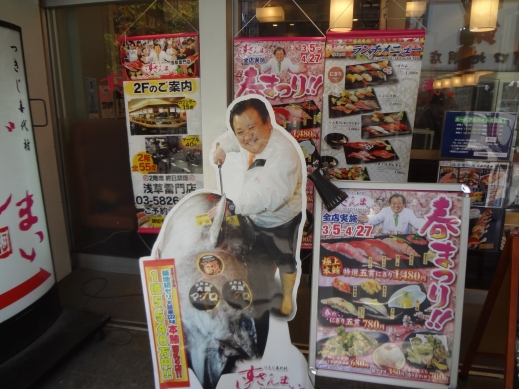
 We could have sat at the counter and watched the staff making the sushi, the process never stops, all day every day. The menu was all in Japanese (of course), but with pictures and having Masaharu with us, we were able to ask questions.
We could have sat at the counter and watched the staff making the sushi, the process never stops, all day every day. The menu was all in Japanese (of course), but with pictures and having Masaharu with us, we were able to ask questions. Masaharu and I had small battered items (not sure what was in them, but they were tasty) . The jug was full of Sake and small cups for our use. Masahaeu poured mine and I poured his, and Maureen’s. Sake is a rice wine with an alcoholic percentage of about 15%. It had been years since my last drink of Sake.
Masaharu and I had small battered items (not sure what was in them, but they were tasty) . The jug was full of Sake and small cups for our use. Masahaeu poured mine and I poured his, and Maureen’s. Sake is a rice wine with an alcoholic percentage of about 15%. It had been years since my last drink of Sake. We ordered a mix of sushi with various different centers and pickles, (the white item on the left). All eaten with chop sticks of course (hashi in Japanese).
We ordered a mix of sushi with various different centers and pickles, (the white item on the left). All eaten with chop sticks of course (hashi in Japanese).


 Like many of our fellow passengers we wondered over to the shopping area and the Ferris wheel. It was obvious that Shimizu was a popular place for private boats.
Like many of our fellow passengers we wondered over to the shopping area and the Ferris wheel. It was obvious that Shimizu was a popular place for private boats.
 They do say that size doesn’t matter, but this one looked a fine vessel, not sure if it offered trips round the bay, or if it was a private yacht.
They do say that size doesn’t matter, but this one looked a fine vessel, not sure if it offered trips round the bay, or if it was a private yacht. Of course talking of size – you can see the Diamond Princess alongside.
Of course talking of size – you can see the Diamond Princess alongside.
 Another shot of the ship as we started our descent.
Another shot of the ship as we started our descent. Taken from the ground level.
Taken from the ground level. The shopping centre, which was not all that large, also catered for the children.
The shopping centre, which was not all that large, also catered for the children. Everyone seemed to be clicking cameras and they all pointed at Mt Fuji – we just couldn’t help taking more and more photographs. It seemed to hold a fascination for everyone.
Everyone seemed to be clicking cameras and they all pointed at Mt Fuji – we just couldn’t help taking more and more photographs. It seemed to hold a fascination for everyone.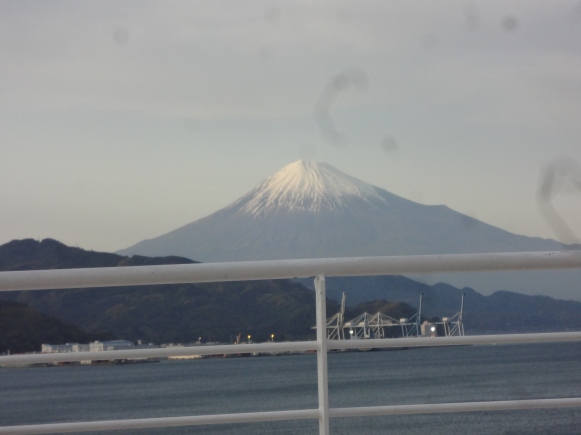 As we sailed from Shimizu I remembered an old Japanese sage saying, during my time at sea when on the Japanese coast. If you see Mt Fuji as you leave you will return to Japan – each time we sailed from Japan I managed to see Mt Fuji, except the last time when we sailed at night, so I was unable to see the mountain – this would have been in the late 1960’s.
As we sailed from Shimizu I remembered an old Japanese sage saying, during my time at sea when on the Japanese coast. If you see Mt Fuji as you leave you will return to Japan – each time we sailed from Japan I managed to see Mt Fuji, except the last time when we sailed at night, so I was unable to see the mountain – this would have been in the late 1960’s. I forgot to mention that our guide in Osaka, Toichi, took out his felt tip pen and created the above in Japanese script.
I forgot to mention that our guide in Osaka, Toichi, took out his felt tip pen and created the above in Japanese script. This type of street is in my memory of Osaka of the early 60’s – just across the bay from Osaka is Kobe, and both towns had many similar style of streets.
This type of street is in my memory of Osaka of the early 60’s – just across the bay from Osaka is Kobe, and both towns had many similar style of streets.


 Toichi and I decided on the same dish – pork in egg (similar to a large omelette)
Toichi and I decided on the same dish – pork in egg (similar to a large omelette) The main dish with the red ribbon is the egg / pork, which was still cooking over flames – the red ‘ribbon’ is so that you can removed the lid without burning your fingers. The heptagon on the left contained rice, the yellow food is a type of pickle, the black pot contained soup and the white food is tofu. As you see Toichi had the same.
The main dish with the red ribbon is the egg / pork, which was still cooking over flames – the red ‘ribbon’ is so that you can removed the lid without burning your fingers. The heptagon on the left contained rice, the yellow food is a type of pickle, the black pot contained soup and the white food is tofu. As you see Toichi had the same.


 One of the smallest, if not the smallest, temple in Osaka – unfortunately I can’t remember what Toichi said about it.
One of the smallest, if not the smallest, temple in Osaka – unfortunately I can’t remember what Toichi said about it. Space being at a premium inside, the staircase is on the outside of this house.
Space being at a premium inside, the staircase is on the outside of this house. A small Shinto shrine – drop a coin in to the box and take a roll of paper (they look like cigarettes). open the roll and read your fortune. If you don’t like your what it says, tie the paper to the red/black fence on the right, and walk away leaving your bad fortune behind you.
A small Shinto shrine – drop a coin in to the box and take a roll of paper (they look like cigarettes). open the roll and read your fortune. If you don’t like your what it says, tie the paper to the red/black fence on the right, and walk away leaving your bad fortune behind you. The food market – many foreigners come here, just to stroll around and perhaps taste some of the local food.
The food market – many foreigners come here, just to stroll around and perhaps taste some of the local food. Would you like a white strawberry – not sure of the weight, but the box will cost you about AUD $56.25
Would you like a white strawberry – not sure of the weight, but the box will cost you about AUD $56.25
 Traditional bento meal
Traditional bento meal Japanese butcher stall – it all looked very attractive, but I lost my appetite as I worked out the cost. The top one with a price of 255 yen is per 100 grams, which equates to AUD $32 / kilo. The bottom right at 280 yen = AUD $35 / kilo.
Japanese butcher stall – it all looked very attractive, but I lost my appetite as I worked out the cost. The top one with a price of 255 yen is per 100 grams, which equates to AUD $32 / kilo. The bottom right at 280 yen = AUD $35 / kilo.
 Further in to the market and more stalls.
Further in to the market and more stalls. Fish stalls, mainly shell fish, which is not my favourite fish food.
Fish stalls, mainly shell fish, which is not my favourite fish food. Staff are constantly advertising to encourage pedestrians to enter their restaurant – just the type of restaurant that I didn’t wish to visit for lunch.
Staff are constantly advertising to encourage pedestrians to enter their restaurant – just the type of restaurant that I didn’t wish to visit for lunch. Across the way from the smiley guy was a large octopus to encourage one to visit – we didn’t.
Across the way from the smiley guy was a large octopus to encourage one to visit – we didn’t.
 It didn’t matter how big your crab was, I wasn’t interested . . .
It didn’t matter how big your crab was, I wasn’t interested . . . I definitely didn’t want a blow fish meal . . . not sure if the sign to the left of the blow fish is for a hot dog or a nail brush.
I definitely didn’t want a blow fish meal . . . not sure if the sign to the left of the blow fish is for a hot dog or a nail brush.

 The Glico running man. He’s doing well considering, because he has been running since 1935.
The Glico running man. He’s doing well considering, because he has been running since 1935. There were plenty pf people around when we were there, but the crowds grow in the evening. The bridge that can be seen is the Ebisu Bridge.
There were plenty pf people around when we were there, but the crowds grow in the evening. The bridge that can be seen is the Ebisu Bridge.
 We arrived early morning in to the port of Osaka in Japan. The weather was overcast, but it wasn’t raining, which was a good sign.
We arrived early morning in to the port of Osaka in Japan. The weather was overcast, but it wasn’t raining, which was a good sign. The port authorities seemed please to see us. Different coloured water jets from a local tug boat.
The port authorities seemed please to see us. Different coloured water jets from a local tug boat. This is for those readers who like shopping.
This is for those readers who like shopping.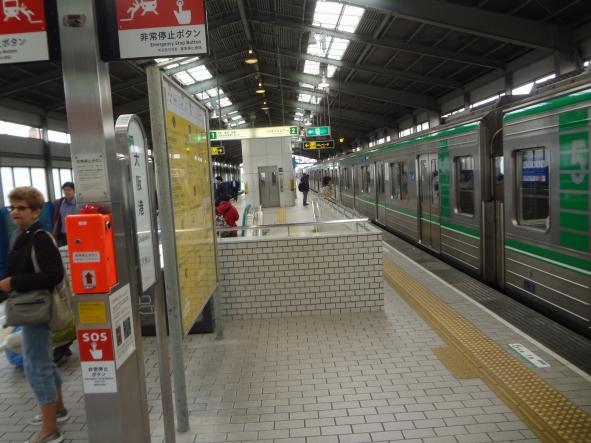 Rush hour was over by the time we had met our guide, Toichi, and made our way to the local metro station. The station was spotless and I didn’t see any graffiti or litter.
Rush hour was over by the time we had met our guide, Toichi, and made our way to the local metro station. The station was spotless and I didn’t see any graffiti or litter. Maureen and our guide Toichi holding a map of the rail system.
Maureen and our guide Toichi holding a map of the rail system. I doubt that we would see such a notice on Sydney rail.
I doubt that we would see such a notice on Sydney rail. We changed trains from the dock area train to a city metro – still didn’t see any litter or graffiti. Our new train is arriving.
We changed trains from the dock area train to a city metro – still didn’t see any litter or graffiti. Our new train is arriving.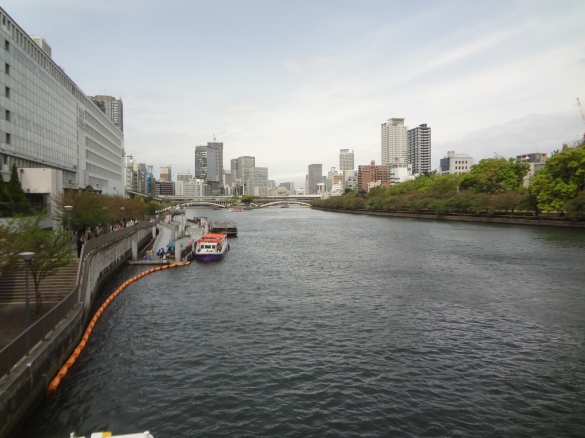 We exited the rail system and made our way towards the mint (as in money), to view the famous cherry blossom.
We exited the rail system and made our way towards the mint (as in money), to view the famous cherry blossom.


 Throughout the gardens are lamps as shown in the photograph and these are lit at night, which I should imagine would add to the whole experience.
Throughout the gardens are lamps as shown in the photograph and these are lit at night, which I should imagine would add to the whole experience. Crowds thinned as they spread out across the gardens.
Crowds thinned as they spread out across the gardens.

 There were a few white blossom cherry trees.
There were a few white blossom cherry trees. For such an important event as the Cherry Blossom season the media were on hand photographing the crowds for newspapers and filming for evening TV news broadcast.
For such an important event as the Cherry Blossom season the media were on hand photographing the crowds for newspapers and filming for evening TV news broadcast. Loud speakers warned in Japanese, Chinese (Mandarin I suppose) and English, not to pick the flowers or to break the branches, and not to walk on the grass. I did notice the security people chasing certain Asian visitors from a large country with a long wall. But most obeyed the request.
Loud speakers warned in Japanese, Chinese (Mandarin I suppose) and English, not to pick the flowers or to break the branches, and not to walk on the grass. I did notice the security people chasing certain Asian visitors from a large country with a long wall. But most obeyed the request. We left the blossom tree area and entered the food sales area to make our way to Osaka Castle, which was to be our next place to visit.
We left the blossom tree area and entered the food sales area to make our way to Osaka Castle, which was to be our next place to visit.
 I did ask our guide what various items where, but I was more interested in the colourful display.
I did ask our guide what various items where, but I was more interested in the colourful display. This was a different way of cooking BBQ fish over hot coals.
This was a different way of cooking BBQ fish over hot coals.






 Osaka Castle
Osaka Castle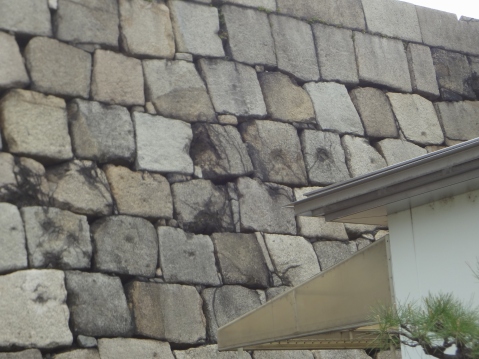 As we walked up to the castle, damaged areas from the bombing during WW2 was pointed out to us. Note the black marks.
As we walked up to the castle, damaged areas from the bombing during WW2 was pointed out to us. Note the black marks.


 Shinto Temple within the castle grounds.
Shinto Temple within the castle grounds.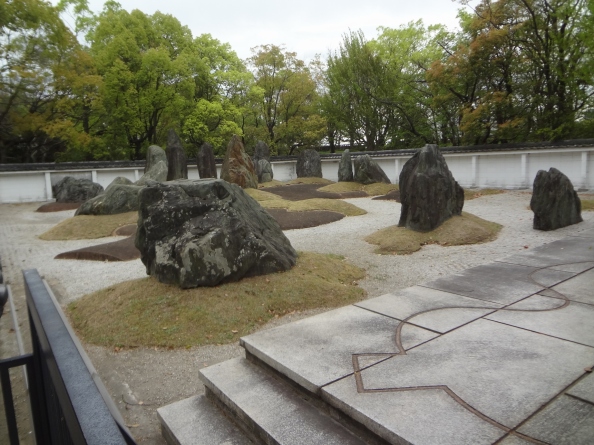

 The trains are beginning to get crowded.
The trains are beginning to get crowded.





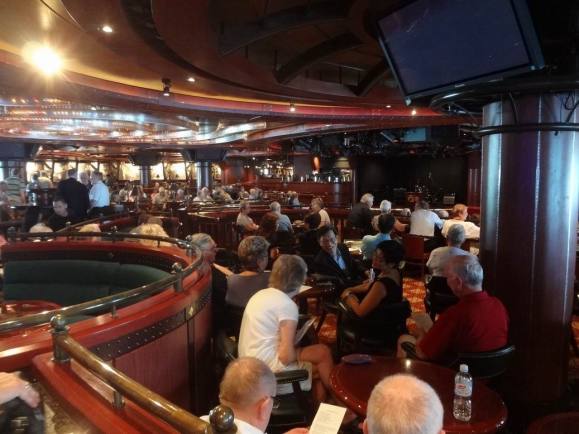




 Crooners Bar, pre lunch drinks on Easter Sunday.
Crooners Bar, pre lunch drinks on Easter Sunday. How things have changed since my first trip to Hong Kong in 1963. Note the clock tower to the left of the picture, right on the waterfront, more about it later.
How things have changed since my first trip to Hong Kong in 1963. Note the clock tower to the left of the picture, right on the waterfront, more about it later.


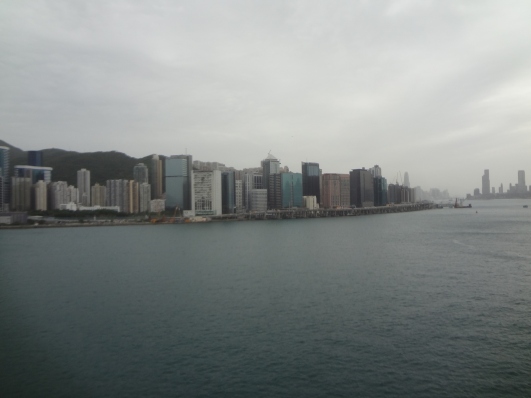
 The cruise terminal used to be the int’l airport Kai Tak, which had a hair-raising runway to land on in the early 1960’s. As the aircraft came in to land, and if the passengers looked out of the window, they could see in to the local apartments.
The cruise terminal used to be the int’l airport Kai Tak, which had a hair-raising runway to land on in the early 1960’s. As the aircraft came in to land, and if the passengers looked out of the window, they could see in to the local apartments. Not everyone landed safely – China Airways missed the runway or couldn’t stop in time.
Not everyone landed safely – China Airways missed the runway or couldn’t stop in time.

 I suppose I was a little ambitious thinking that we could have lunch at an acceptable price, particularly as I took this photograph a helicopter lifted from the roof – the only way to travel really in crowded Hong Kong.
I suppose I was a little ambitious thinking that we could have lunch at an acceptable price, particularly as I took this photograph a helicopter lifted from the roof – the only way to travel really in crowded Hong Kong. The rest of us would have to put up with being met at the airport in a green Rolls Royce.
The rest of us would have to put up with being met at the airport in a green Rolls Royce.
 I tried to capture the green of the Rolls, but the day was a dull and the gleaming ‘green’ duco didn’t show up in the photograph.
I tried to capture the green of the Rolls, but the day was a dull and the gleaming ‘green’ duco didn’t show up in the photograph. It was late morning and many were finishing their breakfast, while others were having a pre-lunch drink. I ordered a beer and an iced-coffee for Maureen. To be fair they came with peanuts, chocolate thingies, and something else that I can’t remember. The bill came to over AUD $27, which wasn’t bad for such an establishment, and it gave us a chance to read the menu.
It was late morning and many were finishing their breakfast, while others were having a pre-lunch drink. I ordered a beer and an iced-coffee for Maureen. To be fair they came with peanuts, chocolate thingies, and something else that I can’t remember. The bill came to over AUD $27, which wasn’t bad for such an establishment, and it gave us a chance to read the menu.

 It was a short walk to the Star Ferry at Tsim Sha Tsui in Kowloon.
It was a short walk to the Star Ferry at Tsim Sha Tsui in Kowloon. If everything else has changed the Star Ferry seems to be stuck in a time warp.
If everything else has changed the Star Ferry seems to be stuck in a time warp. Still the same system to come alongside – the ferry terminal is the same one that I remembered from the earl 60’s.
Still the same system to come alongside – the ferry terminal is the same one that I remembered from the earl 60’s.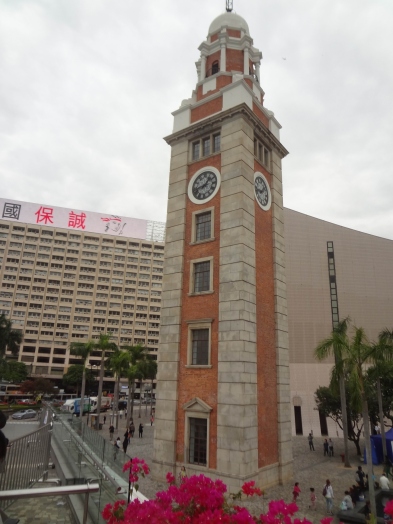
 Reclaimed land perhaps, but the area has certainly been ‘beautified’, I think it used to be a bus terminus in this area.
Reclaimed land perhaps, but the area has certainly been ‘beautified’, I think it used to be a bus terminus in this area.


 We used our side thrusters to push off the wharf and begin the short transit to the open sea.
We used our side thrusters to push off the wharf and begin the short transit to the open sea.
 Farewelling Hong Kong was a cold business in April.
Farewelling Hong Kong was a cold business in April.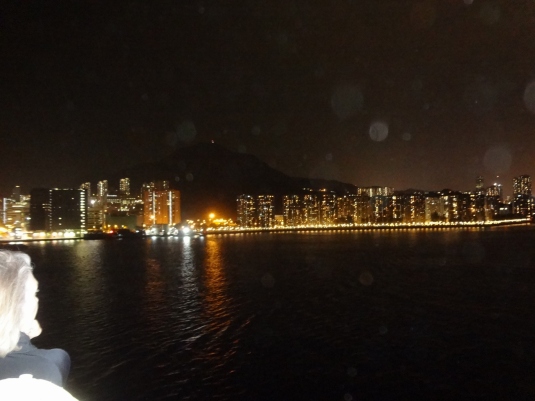 A final shot of the blocks of flats before we disappeared inside the accommodation for a spot of warmth.
A final shot of the blocks of flats before we disappeared inside the accommodation for a spot of warmth.
 Forecourt of the museum – the entrance to the building is on the left.
Forecourt of the museum – the entrance to the building is on the left.


 As we climbed the stairs we met some old friends, Henry VIII
As we climbed the stairs we met some old friends, Henry VIII Admiral Nelson
Admiral Nelson
 Pikeman from the 1600’s
Pikeman from the 1600’s The 2nd floor focused on the Napoleonic wars – French, British, Russian & Dutch exhibits.
The 2nd floor focused on the Napoleonic wars – French, British, Russian & Dutch exhibits. A display of British uniforms through the ages.
A display of British uniforms through the ages. A display of mementos for Long Tan, and the 50th anniversary of the battle,
A display of mementos for Long Tan, and the 50th anniversary of the battle,
 Memorial service for the 50th anniversary of the battle.
Memorial service for the 50th anniversary of the battle.